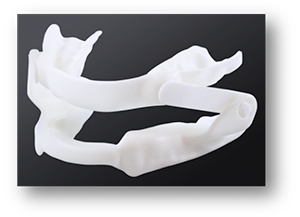Overview
- Clinically Proven, FDA Approved, Compliant Treatment
- Digitally designed and manufactured using a laser sintering process. This offeres a better fit to minimize discomfort and increase stability.
- Connecting rods hold jaw in a forward position; Rods available in 0.5mm and 1mm incriments
Benefits of the DSAD
- Non-invasive, reversible, short or long-term treatment
- Excellent patient compliance due to comfort, durability, effectiveness and the absence of side effects
- Made from a durable material designed to minimize bulk and improve patient compatabiity and comfort
- Easy adjustment, titration, insertion, and removal both for the dentist and the patient


Benefits of the Panthera Connection System
This innovative system transfers forces in the horizontal plane. It reduces muscle pain and stress on the temporomandibular joints (TMJ). Since the retaining rods and the pivot points located on the triangles of the lower retainer and on the anchor points of the upper retainer are elevated, vertical forces are supressed. The fact that there are no vertical forces limits the retention of the retainers to strong teeth, which increases comfort and, consequently, improves patient compliance to the treatment. The device works in the same direction than the muscles and the design minimizes the size and the retention force of the retainers to provide an improved comfort and protect the teeth. The traction mechanism allows the closing of the mouth while reducing tension in the joints. The closing of the mouth contributes to nasal breathing, which reduces vibrations resulting in snoring, as well as collapsing causing episodes of apnea. The Panthera device facilitates lateral and vertical movements during sleep. Consequently, it is also possible to breathe through mouth. Wearing the device does not stop the patient from drinking, yawning or talking. The components of the plastic connector system are safe and metal free. There is no risk of swallowing or inhaling the components. By changing the retaining rods, it is possible to move the jaw forward gradually, one millimetre at a time, in accordance with medical recommendations.
